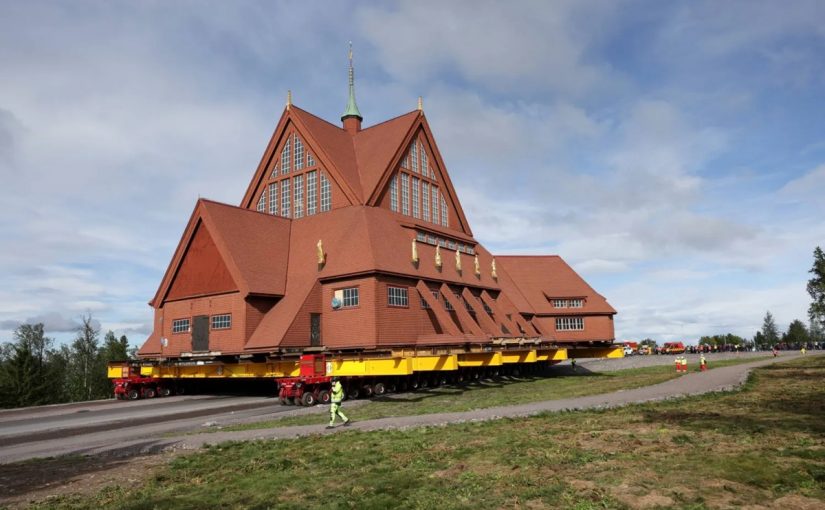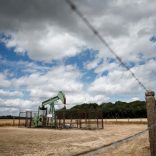Trump hits dozens of countries' goods with steep tariffs
A Swedish church is moving 3 miles down the road, relocating before a mine swallows the town

Kiruna's old wooden church is moved during a two-day relocation trip to a new site next to a cemetery, to save its wooden walls from ground subsidence and the expansion of the world's largest underground iron ore mine, in Kiruna, Sweden August 19, 2025. [Photo: Reuters /Leonhard Foeger]
How do you move one of Sweden’s most beloved wooden churches down the road? With a little bit of engineering, a lot of prayer — and some Eurovision for good luck.
The Kiruna Church — called Kiruna Kyrka in Swedish — and its belfry are being moved this week along a 5-kilometer route east to a new city center as part of the town’s relocation. It’s happening because the world’s largest underground iron-ore mine is threatening to swallow the town.
This week, thousands of visitors have descended upon Kiruna, Sweden’s northernmost town at 200 kilometers above the Arctic Circle. It’s home to roughly 23,000 inhabitants, including members of the Sami Indigenous people, spread over nearly 19,500 square kilometers.
Lena Tjärnberg, the church’s vicar, kicked off the move with a blessing Tuesday morning. The journey is scheduled to end Wednesday afternoon.
The church was a gift from the mining company
In 2001, the Swedish people voted the wooden church the “best building of all time, built before 1950” in a poll connected to the Ministry of Culture. Built on a hill so worshippers could overlook the rest of Kiruna, the Swedish Lutheran church was designed to emulate the Sami style as a gift from LKAB, the state-owned mining company.
The Kiruna mine itself dates back to 1910 and the church was completed in 1912. Its neo-Gothic exterior is considered the town’s most distinctive building and tourists regularly traveled there before it was closed a year ago to prepare for the relocation. It’s set to reopen in the new location at the end of 2026.
Tjärnberg said the final service in the old spot was bittersweet.
The spectacle
This week’s move has turned into a two-day highly choreographed media spectacle, run by LKAB and featuring an appearance by Swedish King Carl XVI Gustaf. Musical performances will include a set from KAJ, Sweden’s 2025 Eurovision entry that was the bookies’ favorite to win this year’s contest but lost out to classically trained countertenor JJ of Austria.
SVT, Sweden’s national broadcaster, is capitalizing on the showcase and is livestreaming the move both days, billing it as “The Great Church Walk” to play off its success with the spring showing of “The Great Moose Migration” that has enthralled millions of viewers annually since 2019.
Known for both the Midnight Sun and the Northern Lights, Kiruna and the surrounding area is a major draw year-round for visitors to Swedish Lapland. The region also features the Aurora Sky Station, the Icehotel and Kebnekaise, the Nordic country’s highest mountain.
British tourists Anita and Don Haymes had already trekked to Kiruna twice before this year’s trip. When they heard about the church’s move, they changed their itinerary to ensure they’d be here for it. They took photographs of it propped up on beams and wheels this week before the move.
“It’s an amazing feat that they are doing,” Anita Haymes said Sunday. “It’ll be interesting to see it moving, unbelievable.”
But not everyone is thrilled about LKAB’s extravaganza. Lars-Marcus Kuhmunen, chairman of one of the Sami reindeer herding organizations in Kiruna, said LKAB’s plans for a new mine could threaten reindeer migration routes and imperil the livelihood of herders in the area.
The mechanics behind the move
The move of Kiruna’s town center, including the church, has been in the works since 2004. As the mine expanded deeper underground, residents began seeing cracks in buildings and roads. In order to reach a new depth of 4,478 feet — and to prevent Kiruna from being swallowed up — officials began moving buildings to a new downtown at a safe distance from the mine.
As of July, 25 buildings had been lifted up onto beams and wheeled east. Sixteen, including the church, remain.
At approximately 131 feet wide with a weight of 741 tons, the church required extra effort. Engineers widened a major road from 30 to 79 feet and dismantled a viaduct to make way for a new intersection.
A driver, using a large control box, is piloting the church through the route as it travels roughly 12 hours over Tuesday and Wednesday — with a pause each day for fika, the traditional Swedish afternoon coffee break. It’s expected to move at a varying pace between 0.31 and 0.93 miles per hour.
Stefan Holmblad Johansson, LKAB’s project manager for the move, would not say how much it has cost the mining company.
The Associated Press













Leave a Reply
Be the First to Comment!
You must be logged in to post a comment.
You must be logged in to post a comment.